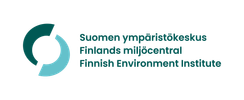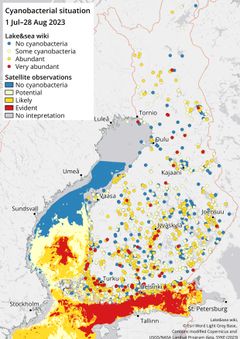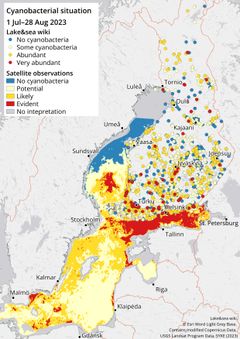Summary of the national blue-green algae monitoring June-August 2023: Varying blue-green algae summer both in lakes and at sea
During the summer, the blue-green algae situation varied due to changes in weather conditions. The blue-green algae blooms became more abundant with warm weather following Midsummer. The peak of the observations was reached in lakes and on the coast in mid-July. In the open sea, the blue-green algae season began at the end of June.
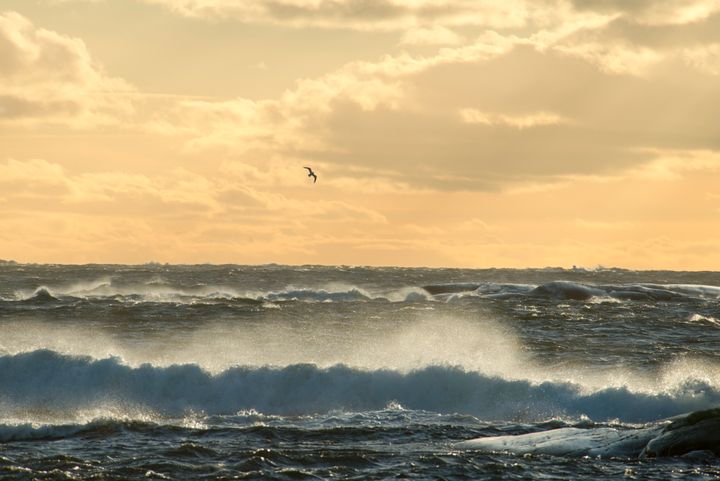
This summer, national blue-green algae monitoring included some 240 observation sites on inland waterways, of which about half did not have any blue-green algae blooms. A small amount of blue-green algae occurred at least once at 95 observation sites, abundant algae at 24 sites and very abundant algae at 8 observation sites. In coastal areas, a small amount of blue-green algae was observed at 44 of the approximately 100 observation sites, abundant blue-green algae at 18 sites and very abundant blue-green algae at 2 sites. In addition, over 2,300 observations have been made by citizens through the Järvi-meriwiki and vesi.fi service, of which 70% were blue-green algae observations.
The blue-green algae situation in lakes and the coastal areas of the Baltic Sea has varied during the past summer in accordance with the weather conditions. The cool early summer restrained the formation of blue-green algae blooms, and the situation was mainly typical of the time period. After Midsummer, as the weather and waters warmed, blue-green algae blooms became more abundant, and the peak was reached in mid-July. After mid-July, the situation remained mainly typical of the season. In early August, windy and unstable weather kept blue-green algae mixed in the water. Strong winds re-mixed nutrients stored in the sediment into the water, and heavy rainfall washed out nutrients from the catchment area for the use of blue-green algae, the surface blooms of which increased somewhat towards the end of August as the winds settled.
During the summer, blue-green algae blooms were found in nutrient-rich lakes throughout the country. In the coastal areas of the Baltic Sea, blue-green algae blooms were found especially in the southern and south-western coastal areas and in the Archipelago Sea.
During summer 2023, abundant blue-green algae were observed in nearly the entire open sea area of the Gulf of Finland. Compared to recent years, the blue-green algae season in the Gulf of Finland began a week earlier than usual. In the western Gulf of Finland, the abundance of blue-green algae was highest at the end of June. In the open sea area of the Gulf of Finland east of Helsinki, blue-green algae were found in large areas from June to August. Blue-green algae observations were also made in the Åland Sea from June onwards and still in the end of August. In the northern part of the main basin, the widest occurrences of blue-green algae were at the end of June. In the Bothnian Sea there was a large occurrence of blue-green algae from the beginning of July to the beginning of August.
Blue-green algae blooms risk estimate was realised
The risk estimate for blue-green algae blooms issued at the beginning of June was based on the nutrient situation in winter and spring. The availability of phosphorus-based nutrients was predicted to be high in a large sea area. In the main basin of the Baltic Sea and in the Gulf of Finland, the risk of blue-green algae blooms was assessed to be high, and blue-green algae blooms were also predicted for the Bothnian Sea. The blue-green algae bloom risk for this summer was largely realised in the areas indicated in the forecast.
In recent years, blue-green algae blooms in the Bothnian Sea have been more abundant than predicted by the winter nutrient situation. Blue-green algae observations in the Quark area have also increased in recent years. The oxygen and nutrient situation in the Bothnian Sea has changed, which may have affected blue-green algae species and their growth. In terms of changes in the Bothnian Sea ecosystem, further information is needed, which could be used to predict the risk of blue-green algae blooming.
The nutrient situation in the Baltic Sea main basin continues to favour the occurrence of blue-green algae blooms in a large part of the Baltic Sea. In particular, phosphorus keeps the risk of blooms high. However, based on the occurrence of blue-green algae blooms in individual years, no conclusions can be drawn on the development of the state of the Baltic Sea, as the blooms occurrence in risk areas is primarily determined by summer weather conditions.
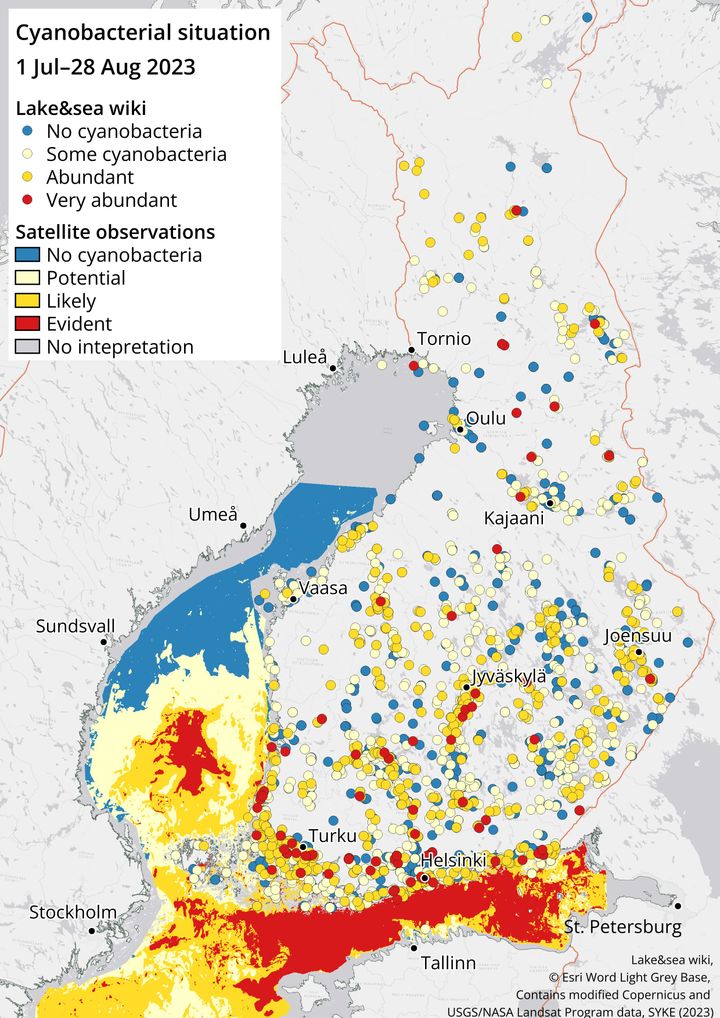
SYKE monitors the occurrence of blue-green algae as part of monitoring the state of the environment
The Finnish Environment Institute SYKE monitors the occurrence of blue-green algae as part of the monitoring of the state of the environment and publishes a weekly overview of the blue-green algae situation in inland waters and in sea areas close to Finland. Monitoring of blue-green algae will continue until the end of September, but the weekly national reports end at the end of August.
The typical time for blue-green algae blooms is from the turn of June-July until August. In late summer, cool nights usually lower the surface temperatures of the waters, which may curb the occurrence of blue-green algae blooms. As the amount of daylight decreases so does the growth of blue-green algae. However, even abundant blue-green algae blooms may still occur in September, and weak blooms may still occur in October-November. If sufficient nutrients are available for blue-green algae, the blooming may continue even under the ice cover. The phycocyanin colour pigment released from degrading blue-green algae cells can stain water and beaches, as well as crevasses to turquoise or blueish in the winter, and form turquoise paint-like mass on the beaches. Degrading blue-green algae mass may also cause an unpleasant smell.
National blue-green algae monitoring has been carried out since 1998. SYKE conducts the monitoring in cooperation with the Centres for Economic Development, Transport and the Environment (ELY Centres) and municipal environmental authorities. Finland’s Rotary is also participating in the blue-green algae monitoring for the fourth year. Citizens can participate in the monitoring by sending their observations to the Järvi-meriwiki through the Havaintolähetti application or via the blue-green algae map service on the vesi.fi website.
Information on the blue-green algae situation in Finland's nearby sea areas was obtained from satellite images, the Finnish Border Guard, the marine research vessel Aranda, measurements of blue-green algae species, biomass and pigment at Utö atmospheric and marine observation station, as well as from cruise and merchant vessels fitted with Alg@line equipment. The Finnish Meteorological Institute's marine services provided up-to-date information on the surface temperature of seawater. The drifting forecasts for blue-green algae mats were prepared weekly in cooperation between SYKE and the Finnish Meteorological Institute's marine services. This year, satellite observations were utilised not only in sea areas but also in 62 lake areas.
SYKE wants to thank all parties involved in blue-green algae observations for their important cooperation!
National algae reporting
- National algae monitoring (Järvi-meriwiki)
- Itämeri.fi algae observations page
- Havaintolähetti
- Algae situation summary
Summer satellite observations can be found in the TARKKA service
Utö atmospheric and marine observation station and Alg@line monitoring
Keywords
Contacts
Inquiries about blue-green algae situationTelephone 1 pm to 3 pm
Lakes: Tel +358 50 5734 347 or +358 295 251 326
State of the Baltic Sea: Tel +358 50 5693 297 or +358 295 251 314
Satellite observations: Tel 358 50 4707 576 or +358 295 251 329, e-mail: Eotuki@syke.fi
Tytti JuustiCommunications Intern
Tel:+358 295 252 323firstname.lastname@syke.fiEija JärvinenCommunication Specialist
Tel:+358 295 251 242firstname.lastname@syke.fiImages
Links
It is time to move beyond solving environmental problems one by one, to systemic sustainability transformations. The Finnish Environment Institute (Syke) contributes to building a sustainable society through research, information and services. The Finnish Environment Institute is a research institute with 700 experts and researchers located in Helsinki, Oulu, Jyväskylä and Joensuu.
Subscribe to releases from Suomen ympäristökeskus
Subscribe to all the latest releases from Suomen ympäristökeskus by registering your e-mail address below. You can unsubscribe at any time.
Latest releases from Suomen ympäristökeskus
Finnish Ecosystem Observatory makes nature data accessible to all22.4.2024 15:13:39 EEST | Press release
The significance of nature data in society has grown significantly in recent years, as decision-making often requires more accurate, up-to-date, and diverse information about nature. The Finnish Ecosystem Observatory project has responded to society's information needs by, for example, building the Finnish Nature Information Hub website. In addition, a group bringing together different organisations has been established to coordinate nature information.
Viikkokatsaus 22.–26.4.202422.4.2024 14:11:46 EEST | Tiedote
Hei! Tässä tiedoksesi meillä Suomen ympäristökeskuksessa tällä viikolla ilmestyviä tiedotteita, uutisia, kampanjoita, blogeja ja uutiskirjeitä. Mukana myös tulevia tapahtumia ja webinaareja. Jakelemme viikkokatsauksen maanantaisin STT:n kautta. Koosteet löytyvät myös STT-uutishuoneesta, josta voit tilata kaikki Suomen ympäristökeskuksen tiedotteet.
Finlands ekosystemobservatorium gör naturinformationen tillgänglig för alla22.4.2024 12:50:17 EEST | Tiedote
Behovet av naturinformation i samhället har de senaste åren ökat kraftigt, eftersom beslutsfattande ofta kräver allt mer exakt, aktuell och mångsidig information om naturen. Inom ramen för det finska ekosystemobservatorieprojektet har samhällets informationsbehov bland annat mötts genom att bygga en gemensam och omfattande plattform, Luontotieto.fi. Dessutom har projektet lett till att en samordningsgrupp för naturinformation har bildats, vilket tidigare inte funnits i Finland.
Luonto koetaan tärkeäksi arkimaisemissa22.4.2024 09:54:55 EEST | Tiedote
Maisemat vaikuttavat ihmisten hyvinvointiin, arvioivat lähes kaikki valtakunnalliseen maisemakyselyyn vastanneista. Tyytyväisyyttä omiin arkimaisemiin tuovat erityisesti vesien ja metsien läheisyys. Useimpien mielestä maisemat tulisi ottaa päätöksenteossa nykyistä paremmin huomioon niin kaupungeissa kuin maaseudullakin.
Naturen upplevs viktig i vardagslandskap22.4.2024 09:54:39 EEST | Tiedote
Landskap påverkar människors välbefinnande, enligt nästan alla som svarade på en riksomfattande landskapsundersökning. Särskilt nöjda är de med närheten till vatten och skogar i sina vardagslandskap. De flesta anser att landskapen bör beaktas bättre i beslutsfattandet både i städerna och på landsbygden.
In our pressroom you can read all our latest releases, find our press contacts, images, documents and other relevant information about us.
Visit our pressroom